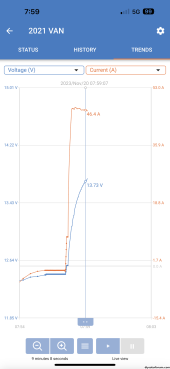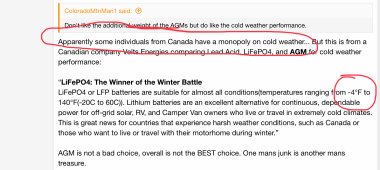Heard very mixed reviews on Renogy. Some love and some don't. I'll look into the Kisae.
Hit/miss on Renogy. Theyve had issues and shortcomings with their product lines however, their batteries and PV panels are solid.
You might want to consider an inverter/charger. I dont typically do a lot of hookup camping however, the charger on my Xantrex has seen a lot of action out of my garage at home. Something to consider. Choosing the right inverter I think will be the most difficult of all your components.
- Our battery box will probably only fit 2x 100Ah batteries. Its under our entrance steps with a flip up lid inside the camper, probably gets some warming from camper and batts. I've insulated the box somewhat on bottom and sides by cutting down a foam ground sleeping 3/4" mat and will improve that and seal the vent when I go to Lithiums or AGMs (sealed).
There are a few ways to keep your batteries warm. Insulation is one of the best ways - spending less power with your warming solution - especially if you get non-heated batteries.
Don't like the additional weight of the AGMs but do like the cold weather performance.
Apparently some individuals from Canada have a monopoly on cold weather... But this is from a Canadian company Volts Energies comparing Lead Acid, LiFePO4, and
AGM for cold weather performance:
“
LiFePO4: The Winner of the Winter Battle
LiFePO4 or LFP batteries are suitable for almost all conditions(temperatures ranging from -4°F to 140°F(-20C to 60C)). Lithium batteries are an excellent alternative for continuous, dependable power for off-grid solar, RV, and Camper Van owners who live or travel in extremely cold climates. This is great news for countries that experience harsh weather conditions, such as Canada or those who want to live or travel with their motorhome during winter.”
AGM is not a bad choice, overall is not the BEST choice. One mans junk is another mans treasure.
-Solar can get defeated by snow on the panels here in winters so can't rely on it and probably won't climb on top of truck camper in the winter to clean them off. Plus it doesn't seem that efficient yet. I like the ideas of getting a portable 200W panel with one connection, will look at that. I'll still probably add two rigid 100W panels to the roof rack likely and can just wire that into my existing single 100w roof panel since its got easy existing Mc-4 connection on roof I can split off of. I don't want to add to much weight on roof since it takes from my overall payload and don't want to block vents, antennas, and A/C on roof. Truck campers don't have a lot of room on roof for panels.
Roger that on the simplicity of the existing MC4 connection and adding additional same spec panel(s). Sounds like you are set on this part.
- I like the idea of the DC to DC charger having a 6.7L Diesel engine on the truck with spare amps and charging when I travel site to site. I have the oversized alternator based on the camper/snow plow package.
Good point about having to clear off the panels of snow. And while its not advisable to idle charge DC-DC baking the alternator (your experience may vary), Ive been out in snow storms with no sun to be had, and you gotta do what you gotta do.
-Honda 2200 gen has worked flawless for 3-4 years with simple maintenance, but yes, I don't want to carry too much gasoline. I run it for coffee pot, toaster, microwave, and to charge up batts. Never adjusted carb for altitude runs fine camping up over 10,000'.
I dont bring a generator boondocking. With improvements to a larger capacity lithium bank, solar, and DC charger, your small Honda gen will be only a backup (depending on how long you want to stay or get stuck in adverse weather).
I live at over 8,500'
-We rarely use A/C unit in summer here in high country. Maybe 3 years ago but think I'll use it more when we visit warmer locations eventually.
-Propane, I have two 30# (7gal) bottles onboard. They of course last much better boon docking in winter than my old two 20# (4.2 gal) bottles. Propane heat is my go to in winter and its cheap in Colorado. I don't use an auxiliary heater as I don't want to defeat my tanks being heated when furnace runs and has blower vents to the tanks and sewer drains areas. Its a Kombi furnace that Lance introduced around 2018 (year of my 1172) and its quieter and more efficient than my old dometic furnace in a previous older truck camper.
To further reduce consumption of propane and perhaps cut down to one tank or maybe two smaller ones (?) I would reiterate to consider a diesel heater. But if it aint broke, dont fix it.
- I'm not sure I want to tear out the Onan generator yet and convert it to another battery box. Thought about it but there are some big pros (weight reduction) and cons (resale value loss, ease of pushing a button, redundancy if Honda fails or run out of gas in a pinch), etc.
If propane is working for your needs, at least if you didnt have or didnt have to use the Onan, your two tank supply should never be an issue. This of course would be contingent on your available power capacity, the ability to do without that green monstrosity.
- No idea yet on which inverter I'll get. probably a 2000w will more than do if we are careful with coffee maker, MW, and toaster sequencing...
If you use a microwave or coffee maker regularly, your choice of quality inverter becomes more critical IMO. My Xantrex 3000 has a chorus of mixed reviews. I guess I got a good one. A 2000W will suffice for your needs. Need to find the one with the most responsive
customer service. From what Ive read more recently that would remove Renogy from your list of inverters.
- Any other thoughts on heated LIFEPO4 batteries? I saw Weize has these for only $269 now for 100ah on Amazon.
For simplicity sake, on paper heated batteries are a major convenience. As they are a more recent offering I have not heard much feedback on useage/problems. Theyre either working perfectly, or not much use case reported yet.
For added complexity you could devise your own method for warming. My battery bank sits under chassis exposed to ambient. I built a heating plate for my PQ Mini’s, uses 50W max, operates automatically from a temperature relay. Some people simply use an incandescent bulb to maintain heat in a well insulated box. As I have the means/ability to make a battery warmer, I choose not to pursue self-heating batteries - one less thing to go wrong.
I think you can have something wrong with any battery cheap or expensive. Again, customer service goes a long way. Power Queen was VERY responsive for a return on my Black Friday purchase. Received a replacement no questions asked in two days - I think they are a LiTime company.
Funny I just got done bashing Renogy for customer service but for a quality build consider their recent REGO batteries, I believe they are heated as well. I would buy Renogy batteries again. (Their customer service was good a few years ago. They answered all my questions and even called me for two separate issues.)
- if I run 500w of solar on a 150V 45 Amp system in really cold or hot temps do you think I'm ok or overkill? MPPT Calculators are still confusing to me as a newby.
PV panels are rated for Standard Test Conditions (STC) which lists maximum and optimum power capability at a nominal operating temperature. The typical “RV” panels are created for “12volt” systems and rate 18-20Volts. However, in colder comditions the panel voltage will reach closer to its open circuit rating (Voc). Should always spec a solar charge controller (SCC) for approx 15-20% more than your operation. So a panel
capable of pushing 20Vmax should have a controller capable to receive 24V for example. Just a general rule for most electronics. Your mileage may vary (YMMV).
To answer your question you have to sum the voltage for series wired panels, and sum the current for parallel wired panels. But keep both voltage AND current spec’d properly for totals on both either way. You cannot spec a SCC solely on wattage. You need to know the Voc and Ioc totals for the panel(s).
Thank you again for thoughts and advice.
Please come back and share your experience with what you do.







